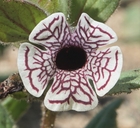Taxon Report
Diplacus pictus (Curran ex Greene) G.L. Nesomcalico monkeyflower |
 © 2020 Matt C. Berger |
Taxon Summary
Diplacus pictus, commonly known as calico monkeyflower, is a annual herb in the Phrymaceae that is found only in California. It occurs within Broadleafed upland forest, and Cismontane woodland, growing at elevations from 100 to 1430 meters. Diplacus pictus is ranked 1B.2, Plants Rare, Threatened or Endangered in California and Elsewhere; Moderately threatened in California.Classification
|
Scientific Name: |
Diplacus pictus (Curran ex Greene) G.L. Nesom |
|
Common Name: |
calico monkeyflower |
| Family: | Phrymaceae |
| Element Code: | PDSCR1B240 |
| USDA Plants Symbol: | |
|
Synonyms/Other Names: |
|
Ecology and Life History
| Lifeform: | annual herb |
| Blooming Period: Mar-May | Mar-May |
| Elevation: | 100-1430 (330-4690) |
| General Habitats: | Broadleafed upland forest, Cismontane woodland |
| Microhabitat: | Disturbed areas, Granitic |
| Microhabitat Details: |
Conservation Status
| CA Rare Plant Rank: | 1B.2 |
| Global Rank: | G2 |
|
State Rank: |
S2 |
| State List: | None |
| Fed List: | None |
| Other Status: | BLM_S; SB_CalBG/RSABG |
|
CRPR Changes: |
|
Occurrence Data from the CNDDB
| Total Occurrences: | 73 |
| Element Occurrence Ranks: | |
| Excellent (A) | 4 |
| Good (B) | 25 |
| Fair (C) | 6 |
| Poor (D) | 1 |
| None (X) | 0 |
| Unknown (U) | 37 |
| California Endemic: True | |
| California Counties and Islands: Name (Code) | |
| Kern (KRN), Tulare (TUL) | |
| Quads: Name (Quad Code) | |
| Arvin (3511827), Bear Mountain (3511826), Bena (3511836), Chickencoop Canyon (3611838), Cummings Mtn. (3511815), Democrat Hot Springs (3511856), Frazier Valley (3611828), Glennville (3511866), Grapevine (3411888), Keene (3511825), Lebec (3411877), Lindsay (3611921), Loraine (3511834), Miracle Hot Springs (3511855), Mt. Adelaide (3511846), Oil Center (3511848), Oiler Peak (3511835), Onyx (3511862), Pastoria Creek (3411887), Pine Mountain (3511857), Quincy School (3511878), Rio Bravo Ranch (3511847), Rocky Hill (3611931), Sand Canyon (3511868), Success Dam (3611818), Tehachapi NE (3511823), Tehachapi North (3511824), Tehachapi South (3511814), Tejon Hills (3511817), Tejon Ranch (3511816), Weldon (3511863), White River (3511877), Winters Ridge (3411886), Woody (3511867) | |
Threat List Data from the CNDDB
| Threat List Total: | 8 | |
| EOs with Threat Listed: | Total EOs | % of EOs |
| 17 | 23 % | |
| Grazing | 9 | 12% |
| Non-native plant impacts | 4 | 5% |
| Other | 3 | 4% |
| Road/trail construction/maint. | 3 | 4% |
| Foot traffic/trampling | 2 | 2% |
| Mining | 1 | 1% |
| Dam/Inundation | 1 | 1% |
| Erosion/runoff | 1 | 1% |
Citation
California Native Plant Society, Rare Plant Program. 2025. Rare Plant Inventory (online edition, v9.5.1). Website https://www.rareplants.cnps.org [accessed 19 December 2025].